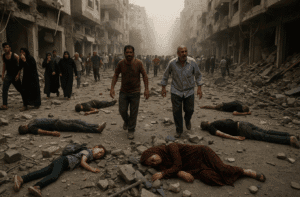Gaza Civilian Toll Soars: 33 Dead in Devastating Airstrike Amid Escalating Humanitarian Crisis
Israeli airstrikes struck a crowded Gaza City restaurant and market on Wednesday, killing 33 Palestinians—including children, displaced families, and a journalist awaiting his newborn—as Israel signals plans to escalate its 19-month military campaign. Survivors described scenes of carnage, with makeshift kitchens and stalls reduced to rubble, underscoring the conflict’s toll on civilians. The strikes follow attacks on schools-turned-shelters, where 59 died earlier this week, deepening fears of indiscriminate violence.
Over 423,000 Gazans have fled renewed fighting since March, joining 1.9 million facing severe hunger amid Israel’s blockade. While Israel claims Hamas operates in civilian areas, critics condemn tactics risking disproportionate harm. With ceasefire talks stalled and famine looming, international calls grow to halt a crisis leaving families trapped between war and starvation.

Gaza Civilian Toll Soars: 33 Dead in Devastating Airstrike Amid Escalating Humanitarian Crisis
The streets of Gaza City were left in ruins Wednesday after Israeli airstrikes struck a bustling commercial area, killing at least 33 Palestinians and injuring dozens more, according to Gaza’s Hamas-run health ministry. The attacks targeted a makeshift restaurant and a market in the Rimal neighborhood, amplifying fears of a worsening humanitarian catastrophe as Israel signals plans to intensify its military campaign against Hamas.
The Human Toll
Footage from the scene showed devastating aftermath: bodies at tables in the Thailandy restaurant, which had recently reopened after being destroyed in earlier fighting and was serving as a community kitchen. Nearby, a child lay lifeless in the street, a backpack still strapped to their shoulders. Witnesses described scenes of chaos, with one woman recounting to Reuters how she escaped the restaurant with her infant and two other children, saying, “Everyone died. The blood was like a lake.”
Among the victims was Palestinian journalist Yahya Sobeih, killed hours after his wife gave birth to their first child—a tragic symbol of the conflict’s indiscriminate toll. Local vendors, families, and displaced individuals seeking meals were among those caught in the strikes, which occurred in quick succession on al-Wahda Street, a once-vibrant thoroughfare now scarred by war.
Broader Context of Escalation
The strikes follow a pattern of heightened violence since Israel resumed its offensive in March after a collapsed ceasefire. Recent attacks on schools-turned-shelters, including a UN-run facility in Bureij refugee camp, have drawn international condemnation. Israel claims these sites housed Hamas operatives, but survivors and aid groups emphasize the civilian cost.
Prime Minister Benjamin Netanyahu’s government has vowed to expand operations, including indefinite control of Gaza, mass displacement of Palestinians southward, and privatized aid distribution—a plan critics argue exacerbates suffering. Over 423,000 Gazans have been newly displaced in recent weeks, joining 1.9 million already facing severe food insecurity, according to UN agencies.
Humanitarian Crisis at a Breaking Point
Aid organizations warn of imminent famine, with Israel’s blockade severely restricting food, water, and medical supplies. Despite Israeli assertions of “no shortage,” the UN reports only a fraction of necessary aid is entering Gaza. Palestinian Authority Prime Minister Mohammad Mustafa described conditions as a “real catastrophe,” urging urgent international intervention to broker a ceasefire.
Legal and Moral Questions
The targeting of civilian infrastructure raises alarms under international law. While Israel asserts its strikes aim to dismantle Hamas, critics accuse it of disproportionate force. The Geneva Conventions prohibit attacks likely to cause excessive civilian harm, yet Gaza’s dense urban landscape complicates military operations. Hamas, meanwhile, faces scrutiny for embedding operations in populated areas, a tactic that heightens civilian risk.
Global Reactions and Stalled Diplomacy
Efforts to negotiate a hostage-release deal and ceasefire have stalled, with Hamas refusing talks amid what it calls Israel’s “starvation war.” The U.S. and regional allies face mounting pressure to mediate, but Netanyahu’s government appears poised to delay major offensives only briefly, pending geopolitical developments.
Voices from the Ground
Local narratives underscore the trauma: a father mourning his family at a bombed school, vendors recounting lost livelihoods, and medical workers struggling with overwhelmed hospitals. “What do they want to achieve?” asked Abu Saleh Abdu, a restaurant owner near the strike sites. “They’ve only hit civilians.”
The Path Ahead
As violence escalates, the international community grapples with limited leverage. The UN Security Council has repeatedly called for ceasefires and aid access, but enforcement remains elusive. For Gaza’s civilians, the immediate future holds little hope—only the grim reality of displacement, loss, and survival amid rubble.
Conclusion
The strikes on al-Wahda Street are a microcosm of Gaza’s broader tragedy: a cycle of retaliation, civilian suffering, and political stalemate. With Israel’s planned escalation and Hamas’s entrenched resistance, the human cost continues to mount. Beyond headlines and casualty counts, the crisis demands a reckoning with the ethics of warfare and the urgent need for dialogue—before more lives are reduced to statistics in an unending conflict.
You must be logged in to post a comment.